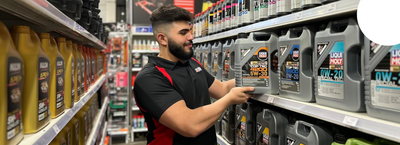Your car’s braking system is one of the most critical components ensuring your safety on the road. Properly functioning brakes allow you to stop quickly and avoid potential accidents. However, brakes can wear out over time, and it’s essential to recognize the signs that they need replacement or maintenance. Ignoring these signs can lead to dangerous driving conditions and costly repairs. In this comprehensive guide, we’ll explore the common signs that your car needs new brakes and what you should do if you notice any of these issues.
Understanding the Basics of Your Car’s Braking System
Before diving into the signs of brake issues, it’s important to understand the basic components of your car’s braking system:
1. Brake Pads
Brake pads are a crucial part of the braking system. When you press the brake pedal, the brake pads are forced against the brake rotors, creating friction that slows down the vehicle. Over time, brake pads wear down and need to be replaced.
2. Brake Rotors
Brake rotors, also known as brake discs, work in conjunction with the brake pads. The rotors are clamped by the brake pads to stop the wheel from turning. Rotors can wear down, warp, or become damaged and may need resurfacing or replacement.
3. Brake Calipers
Brake calipers house the brake pads and use hydraulic pressure to press the pads against the rotors. Calipers can become stuck or damaged, leading to uneven brake pad wear and reduced braking efficiency.
4. Brake Fluid
Brake fluid is a hydraulic fluid that transfers force from the brake pedal to the brake calipers. Low or contaminated brake fluid can lead to reduced braking performance and potential brake failure.
Common Signs Your Car Needs New Brakes
Recognizing the signs that your brakes need attention can prevent more serious issues and keep you safe on the road. Here are the most common indicators that your car needs new brakes:
1. Squeaking or Squealing Noises
One of the first signs of brake trouble is a high-pitched squeaking or squealing noise when you apply the brakes. This noise is often caused by:
- Worn Brake Pads: Most brake pads have a built-in wear indicator that emits a squealing sound when the pads are worn down and need replacement.
- Glazed Brake Pads: If the brake pads become overheated, they can develop a glaze on the surface, leading to squealing noises.
Ignoring these noises can result in further damage to the brake system, so it’s essential to have your brakes inspected promptly.
2. Grinding Sound
A grinding noise when you apply the brakes is a more serious indication of brake problems. This sound usually occurs when:
- Brake Pads Are Completely Worn Out: When the brake pads are entirely worn down, the metal backing plate makes contact with the brake rotor, causing a grinding sound.
- Damaged Brake Rotors: If the brake rotors are damaged or warped, they can produce a grinding noise when the pads contact the uneven surface.
Grinding noises indicate significant brake wear and require immediate attention to prevent further damage and ensure safe braking.
3. Vibration or Pulsation
If you feel a vibration or pulsation in the brake pedal or steering wheel when you apply the brakes, it could indicate:
- Warped Brake Rotors: Over time, brake rotors can become warped due to excessive heat and uneven wear. Warped rotors cause the brake pads to make inconsistent contact, leading to vibrations.
- Uneven Brake Pad Wear: If the brake pads wear unevenly, it can cause a pulsating sensation when braking.
It’s crucial to have a professional mechanic inspect and address these issues to maintain smooth and safe braking.
4. Soft or Spongy Brake Pedal
A soft or spongy brake pedal feel is a sign of a potential problem in the brake system. This issue can be caused by:
- Air in the Brake Lines: Air bubbles in the brake lines can reduce the hydraulic pressure needed for effective braking, making the brake pedal feel soft.
- Low or Contaminated Brake Fluid: Low brake fluid levels or contaminated fluid can lead to a spongy brake pedal.
- Master Cylinder Issues: A failing master cylinder can result in a loss of brake pressure and a soft pedal feel.
Addressing a soft or spongy brake pedal promptly is essential to ensure reliable braking performance.
5. Longer Stopping Distances
If you notice that your car takes longer to stop than it used to, it’s a clear sign that your brakes need attention. Several factors can contribute to increased stopping distances, including:
- Worn Brake Pads: As brake pads wear down, their ability to generate friction decreases, resulting in longer stopping distances.
- Brake Fluid Leaks: Leaks in the brake system can lead to a loss of hydraulic pressure, reducing braking efficiency.
- Faulty Brake Components: Damaged or malfunctioning brake calipers, rotors, or other components can impact the overall braking performance.
Longer stopping distances can compromise your safety, so it’s important to have your brakes inspected and repaired as needed.
6. Brake Warning Light
Most modern vehicles are equipped with a brake warning light on the dashboard. If this light illuminates, it’s a clear indication that there’s an issue with your brake system. Common reasons for the brake warning light to come on include:
- Low Brake Fluid Levels: The brake fluid reservoir may be low, indicating a possible leak or the need for a brake fluid top-up.
- Worn Brake Pads: Some vehicles have sensors that trigger the brake warning light when the brake pads are worn down.
- ABS Issues: Problems with the Anti-lock Braking System (ABS) can also trigger the brake warning light.
Whenever the brake warning light comes on, it’s essential to have your vehicle inspected by a professional mechanic to diagnose and resolve the issue.
7. Pulling to One Side
If your car pulls to one side when you apply the brakes, it could indicate:
- Uneven Brake Pad Wear: Brake pads that wear unevenly can cause the vehicle to pull to one side during braking.
- Stuck Brake Caliper: A caliper that’s stuck or not functioning properly can lead to uneven braking force, causing the car to pull.
- Brake Fluid Leak: A leak in the brake system can result in uneven brake pressure distribution, causing the car to pull.
Pulling to one side during braking can affect your ability to control the vehicle, so it’s important to address this issue promptly.
8. Burning Smell
A burning smell, especially after heavy braking or driving downhill, is a sign that your brakes are overheating. This issue can be caused by:
- Sticking Brake Caliper: A caliper that’s stuck can cause constant friction and heat, leading to a burning smell.
- Overuse of Brakes: Prolonged or excessive use of the brakes, such as during downhill driving, can cause the brakes to overheat.
If you notice a burning smell, it’s essential to stop driving and allow the brakes to cool down. Continuing to drive with overheated brakes can cause damage and reduce braking effectiveness.
9. Brake Fluid Leaks
Brake fluid is vital for the proper functioning of the hydraulic brake system. If you notice any fluid leaks under your vehicle, it’s crucial to check if it’s brake fluid. Common signs of a brake fluid leak include:
- Soft or Spongy Brake Pedal: As mentioned earlier, a soft brake pedal can be a sign of low brake fluid levels.
- Puddles of Fluid: Look for puddles of clear or slightly yellowish fluid near the wheels or under the car.
- Reduced Braking Performance: Leaking brake fluid can lead to a loss of hydraulic pressure, reducing braking efficiency.
Brake fluid leaks should be addressed immediately to prevent brake failure and ensure safe driving.
What to Do If You Notice Brake Issues
If you notice any of the signs mentioned above, it’s essential to take action promptly. Here’s what you should do:
1. Inspect the Brakes
If you’re comfortable and have the necessary tools, you can perform a basic inspection of your brakes. Check the thickness of the brake pads, look for any visible damage to the rotors, and inspect for any leaks or abnormalities. However, for a thorough inspection and accurate diagnosis, it’s best to consult a professional mechanic.
2. Schedule a Brake Inspection
A professional brake inspection can identify the exact cause of the issue and determine whether your brakes need repair or replacement. Many auto repair shops offer free or low-cost brake inspections, which include checking the brake pads, rotors, calipers, brake fluid levels, and overall brake system condition.
3. Replace Worn Components
If the inspection reveals that your brake pads, rotors, or other components are worn or damaged, have them replaced promptly. Using high-quality replacement parts can improve braking performance and extend the lifespan of your brake system.
4. Maintain Your Brakes Regularly
Regular brake maintenance can help prevent issues and ensure your brakes function optimally. This includes:
- Brake Pad Replacement: Replace brake pads according to the manufacturer’s recommendations or when they show signs of wear.
- Brake Fluid Changes: Regularly check and change your brake fluid to prevent contamination and maintain hydraulic pressure.
- Rotor Resurfacing or Replacement: If your rotors are warped or damaged, have them resurfaced or replaced to ensure smooth braking.
5. Monitor Brake Performance
Pay attention to how your brakes feel and sound while driving. If you notice any changes in performance, address them promptly to prevent further damage and ensure your safety on the road.
Conclusion
Your car’s braking system is essential for safe driving, and recognizing the signs of brake issues can help you avoid dangerous situations and costly repairs. By understanding the common signs that your car needs new brakes, you can take prompt action to maintain your vehicle’s braking performance. Regular inspections, timely replacements, and proper maintenance are key to ensuring your brakes remain in good working condition. Prioritize your safety and the safety of others on the road by keeping your brakes in top shape.
At Universal Auto Spares, we're not just here to sell car parts – we're here to fuel your passion for all things automotive. Stay tuned for more informative articles, product spotlights, and expert tips to elevate your driving experience. Until next time, keep the rubber side down and the revs up!









